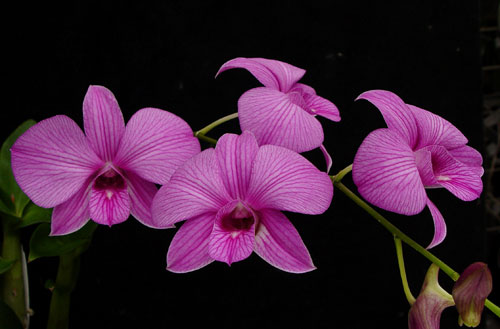Home | Links | References
Taking Care of Your Phalaenopsis Orchid
By Emily Fischbach
The Mysterious Orchid
People have this misconception that taking care of orchids is difficult and only the people with the greenest of the green thumbs should try. This is simply not so. It isn't difficult as long as you take into account the environment that the orchid comes from, and rise to meet their needs. Surprisingly, even if you don't meet their needs completely, they are hardy little plants, and won't keel over and die on you. A peace lily, who will wilt despondently and eventually die, if you don't water it regularly.
Environment
Orchids, at least most that people keep as houseplants, come from the
subtropic/tropical environment. I think it's common knowledge for
most people that orchids are houseplants, and cannot be exposed to
freezing temperatures. They live in crooks and nooks in trees,
with part of their roots exposed to the air, rain, and dappled
sunlight. The phalaenopsis orchids are short day plants.
This means as the days get shorter and the seasons change from summer
to autumn they will flower. The temperatures will be around 75 F
during the day, and get down to 65 F or so at night. Some people
like to use wardian cases or victorian bell jars to help the sunlight
warm the ambient air around the orchid up. I find that a
sunny south east or south west window is sufficient.
They are used to bright, indirect light. A grow light can be used
to supplement the light they get, if you cannot get access to enough
light.

Figure 1: An orchid in its natural environment
http://www.orchidvillage.com/orchidcare/category/orchid-species/
Roots and Soil
Their roots need good drainage
and airflow, and special mixes of clay
balls, bark, vermiculite and charcoal pieces are made specifically for
orchids. This means no peat moss! It does not drain quick
enough, and can predispose the roots to rots. This also mean the
pot
must be clear or have several holes, to let in sunlight because the
roots also photosynthesize. There should be a dish or catchment
under the clear pot, so that substrate above and the air pockets are
humid. Another especially important aspect of the swollen roots
is the kind of water they uptake. Rainwater is best, as it what
they are adapted to. However if you cannot get your hands on
that, you can use distilled, filtered or bottled water. City tap
water is a big no no! Low mineral content and low pH really make
a difference in the health of the plant. Orchids are quite hardy,
and if you water them with city water they will not die; however they
also won't thrive or flower for you. This also means when
you mix up your special orchid fertilizer, you use the good water to
make it. Ah yes fertilizer. Please use fertilizer made for
orchids, and use the recommended amounts. Orchids will not take
well to having tons of fertilizer thrust on them, they will burn and it
will ultimately weaken the plant. Water your orchid once a
week or so. If you look into the pot and do not see water
droplets condensing on the sides, don't worry. Orchids can dry
out a bit between waterings, and it will help reduce the potential for
fungi to move in.
Fertilize every week, (or when you remember) a lack of
fertilizer will also not kill the plant, but it is essential for
flowering. You can even only water your orchid with the special
fertilizer, to ensure blooms each year.

Figure 1: A proper orchid pot with clear plastic, and
healthy roots
http://phalaenopsiscare.net/Repotting_Phalaenopsis_Orchid_Care.html
Leaves and Flowers
The flowers of the orchid family are unlike any other. Their
forms, colors and scents as different and unique as an individual
cloud. They are the whole reason why people grow orchids in the
first place! The leaves are leathery, and as they get older they
may wrinkle and shrivel up on you. Do not cut them off! If
they are still green, they are still being useful in capturing energy
for the plant. Even if they are brown, it still would not be wise
to cut them off. If the plant has not shed them itself, you will
surely cut into green growth. This means an open wound, and with
open wounds, infection can get in. If you do end up accidentally
harming your orchid, take it out of the humid environment and let it
dry out and scab over. Keep it in bright light with UV rays to
inhibit bacterial growth as well. Take some cinnamon and sprinkle
it on the affected area. Cinnamon is an anti-fungal and will
inhibit the growth of undesirables. This also applies to flower
stalks as well. Wait until it has gone through senescence before
cutting it off. I know it may look ugly but it is a small price
to pay for months and months of gorgeous non fading flowers.

Figure 3: Orchids come in a variety of colors and forms
http://www.orchidweb.com/dendcare.aspx
A Success
Orchids are amazing house plants, and much hardier than one would
expect. I rescued my orchid from a neglected greenhouse. He
had one dying leaf, and almost all of his roots were rotted from living
in peat moss. A small ant colony had moved into his clay
pot! The combination of factors would have sealed his fate.
A good pruning of all the rotted roots, and a dousing of cinnamon put a
stop to the fungus, and a re-potting into the appropriate soil and pot,
and he's a new orchid. He now has 4 leaves with one more on the
way. I fertilize weekly, and he's formed lots of new roots.
It's experiences like these that lead me to believe that orchids are
one of the most beautiful, and hardy of the indoor house plants.